Perennial plants are a great way to add life and vibrancy to your garden. They come back year after year, so you don’t have to worry about replanting them every season.
And while many perennials can be hardy and require little maintenance, there are some that are particularly easy to grow.
Eight Easiest Perennials To Grow
These eight perennials are the perfect plants for gardeners of any level. They require minimal maintenance and will give your garden a beautiful boost in color, texture, and fragrance.
Here is a list of the eight easiest perennials to grow in your garden.
Black-Eyed Susan (Rudbeckia)
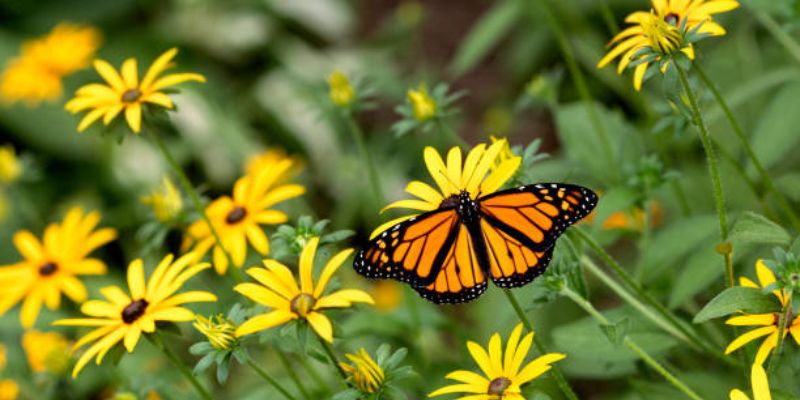
Black-eyed Susan (Rudbeckia) is an easy-to-grow, native perennial that comes in a variety of colors and forms.
The most commonly grown varieties are upright daisy-like plants with yellow and dark brown centers. Plants can reach up to 6 feet tall and feature golden yellow flowers on a single stem and finely cut leaves.
Soil And Light Requirements
Black-Eyed Susans prefer full sun but will tolerate partial shade, especially in hot climates. They do well in any soil type as long as it is well drained; however, they prefer loamy, fertile soils rich in organic matter for optimum growth.
Watering And Fertilization
During their active growing season (spring to early fall) Black-Eyed Susans need 1-2 inches of water per week. During the winter, they should be kept dry.
Liquid fertilizer should be applied every month during their active growing season but not during the dormant period in winter.
Maintenance Tips
Pruning is not necessary for most varieties and can reduce flowering; however, deadheading spent blooms will help encourage additional blooming.
Plants may require division every 3-4 years to maintain vigor, as well as prevent overcrowding and restore overall health.
Common Pests And Diseases
Black-Eyed Susans are generally pests-free but they can be susceptible to aphids, powdery mildew, or rust if grown in overly moist conditions.
Uses In Landscaping
Black-Eyed Susans are popular for their sunny, cheerful appearance and are often used as an accent plant in beds or borders.
They also attract butterflies, bees, and other beneficial insects to the garden and make excellent-cut flowers. They can be grown as a single specimen or planted in groups for an even more impressive display.
Overall, they are easy to care for and make great additions to any landscape.
Daylily (Hemerocallis)
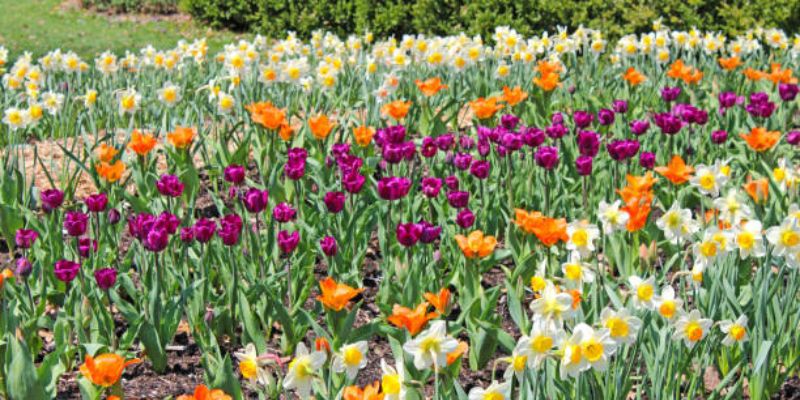
Daylilies are clump-forming perennials that grow from long, fleshy rhizomes. The plant has stiff, upright stems and strappy leaves.
It produces multi-petaled flowers in shades of yellow, orange, pink, and purple. Each flower is open for one day only but the entire flowering period can last up to 6 weeks.
Soil And Light Requirements
Daylilies prefer moist, well-draining soil with a pH between 6.3 – 6.8 and full sun exposure with partial shade in hot climates.
They will tolerate some drought but look their best when watered regularly during dry spells or periods of high heat.
Watering And Fertilization
Water daylilies deeply every other week or as needed to keep the soil moist. Fertilize with a balanced, slow-release fertilizer according to label instructions in spring and summer.
Maintenance Tips
Deadhead spent blooms to encourage continued flowering and to prevent seed formation. Divide daylilies every three years in early spring for the best performance and more flowers.
Common Pests And Diseases
Daylilies are generally pest and disease resistant, but can occasionally be affected by aphids, thrips, slugs, mites, mildew, or rust.
Uses In Landscaping
Daylilies are great for borders or mass plantings along pathways or driveways and make lovely cut flowers too. Their long-lasting flowers and easy care make them a must-have for any garden.
With their bold, showy blooms and easy maintenance, daylilies are among the easiest perennials to grow. They’re sure to bring beauty, color, and texture to your landscape.
Coneflower (Echinacea)
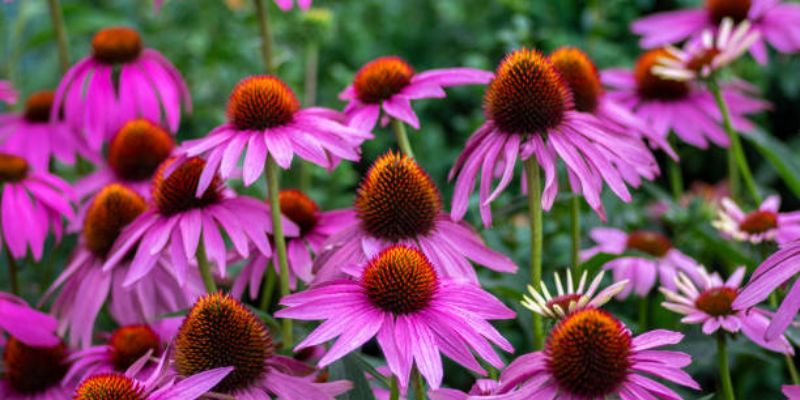
Coneflower (Echinacea) is a popular perennial flower native to southeastern America. It’s known for its daisy-like blossoms with spiny, cone-shaped centers and petals in shades of white, yellow, pink, purple, and orange.
This easy-to-grow plant can reach between 1 to 4 feet in height and spreads up to 2 feet.
Soil And Light Requirements
Coneflowers thrive in full sun but will tolerate partial shade as well.
They prefer soils that are evenly moist yet well-drained. To ensure the best growth and bloom performance, add aged compost or mulch around the plant prior to planting.
Watering And Fertilization
In general, coneflowers don’t need a lot of water. In fact, too much water can lead to root rot and other problems.
Water only when the soil is dry to the touch. Fertilize in early spring with an all-purpose fertilizer according to package directions.
Maintenance Tips
Coneflower is generally low maintenance but may need occasional deadheading (removal of spent flowers) for continued flowering throughout the season.
Plants may also require dividing every three to four years to maintain vigor and prevent overcrowding.
Common Pests And Diseases
Coneflowers are rarely affected by any serious pests or diseases, though deer, rabbits, and voles may nibble on them from time to time.
Additionally, powdery mildew and other fungal diseases may occur in humid weather with inadequate air circulation.
Uses In Landscaping
Coneflowers offer a wide range of uses in the landscape. In addition to providing vibrant color, they attract pollinating insects like butterflies and bees, making them great for adding interest to any garden or outdoor space.
They are also well suited for cut flower arrangements. Try planting them alongside ornamental grasses or other perennials for a striking combination of texture and color.
With proper care and maintenance, coneflowers can be enjoyed year after year. With their vibrant blooms and low-maintenance requirements, these easy-to-grow perennials will bring life to any garden.
Try planting a few this season for a show-stopping display of color and texture.
Bee Balm (Monarda)
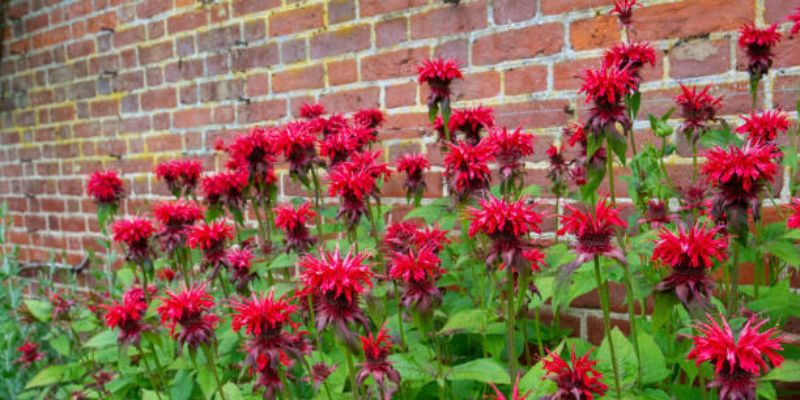
Bee balm (Monarda) is an herbaceous perennial that grows in a variety of shapes and sizes, from small and neat clumps to large mounds.
Its leaves are oval to heart-shaped, with serrated edges. Flower spikes come in shades of pink, red, purple, or white and are shaped like tubes surrounded by petals.
Soil And Light Requirements
Bee balm prefers well-drained soil with a neutral pH level. Plant it in full sun for best flower production; part shade will also work but may reduce the number of blooms produced each year.
Watering And Fertilization
Bee balm can be drought tolerant but generally benefits from regular watering, especially during prolonged dry periods. Fertilize in spring with a balanced fertilizer such as 10-10-10 to encourage growth and flowers.
Maintenance Tips
Cut flower stalks back to basal foliage after flowering is over; this will help the plant rebloom and keep it looking neat. Divide clumps every couple of years if needed, but be sure not to damage the roots when you do so.
Also, remove any dead or dying leaves or stems promptly to reduce disease problems and maintain a healthy appearance.
Common Pests And Diseases
Bee balm can be prone to powdery mildew and fungal leaf diseases in warm climates, so make sure plants receive adequate air circulation by spacing them well apart.
Aphids can also be a problem, so keep an eye out for them and treat them with insecticidal soap if needed.
Uses In Landscaping
Bee balm is ideal for creating informal cottage garden looks, as its loose habit complements other perennials such as daisies, coreopsis, and coneflowers.
It can also be used in containers or at the edge of a sunny border to add color and texture. Its fragrant foliage makes it attractive to bees, butterflies, and hummingbirds. Cut flowers are long-lasting when used indoors in arrangements.
Bee balm is an enjoyable plant to grow due to its ease of care and cheerful flower spikes that bloom all summer long.
With just the right combination of sun, water, and fertilizer, you can have a garden full of colorful blooms that will last for many seasons.
Sedum
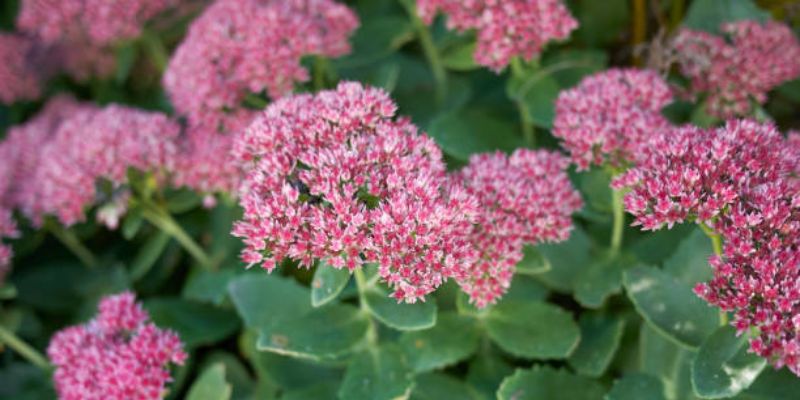
Sedum is a genus of flowering plants in the family Crassulaceae, native to Europe, Asia, and North America. These succulent perennials vary in size from low-growing ground covers to tall-growing shrubs.
The foliage is mainly evergreen with waxy leaves and often grows in rosettes that resemble flowers when viewed from afar. Colorful flowers appear on stems above the foliage during late summer and fall.
Soil And Light Requirements
Sedum prefers full sun or partial shade, but can also tolerate shade provided it has good airflow around it so that the foliage remains dry. It needs a well-draining soil mix such as cactus mix or sandy soil with some organic matter.
Watering And Fertilization
During the active growing season, water frequently enough to keep the soil moist but not soggy, and be sure to let the top two inches of soil dry out before watering. Fertilize with a liquid fertilizer every few weeks during the active growing season.
Maintenance Tips
Deadhead spent flowers regularly to encourage more blooms and prune back old stems in spring for fresh foliage and more blooms.
Common Pests And Diseases
Sedum is generally pest-free but can be susceptible to aphids, mealybugs, or thrips if planted in too much shade or kept overly wet for extended periods of time. Common diseases include root and crown rot, powdery mildew, and blight.
Uses In Landscaping
Sedum is a great choice for rock gardens, borders, beds, or container gardens as it adds a unique texture and form to the landscape.
Its colorful flowers are attractive to hummingbirds and butterflies. It can also be used as an edging plant or ground cover if kept trimmed regularly.
For an easy-care perennial that stands out from the crowd, Sedum is hard to beat. With its evergreen foliage and vibrant flowers, it’s sure to add interest to your garden all year round.
Plus its low maintenance requirements make it ideal for those who don’t have much time for gardening but still want to enjoy its beauty.
Catmint (Nepeta)

Catmint is a perennial herb of the mint family, which is characterized by its fragrant grey-green foliage and long blooming period.
The flowers range from blues to purples, with some varieties reaching up to 8 to 10 inches in height. It should be planted in full or partial sun and can tolerate both hot and cold temperatures
Soil And Light Requirements
Catmint prefers well-drained soils that are slightly acidic, although it will tolerate a variety of soil types if they are not overly wet or soggy.
Once established, catmint is drought tolerant; however, it does best when watered regularly during periods of drought stress. For optimal growth and flowering, it should receive full sun for at least six hours a day.
Watering And Fertilization
Catmint requires regular watering during the first few months of growth until it is established. Once established, water should be applied only when soil is dry to the touch, taking care not to over-water.
Fertilizer is not typically required, although if desired it can be applied in early spring at half strength compared to general-purpose fertilizers.
Maintenance Tips
Deadheading spent flowers will help promote more blooms as well as maintain a tidy appearance of the plant.
Catmint can become leggy over time; trimming back after flowering helps encourage new growth and preserve its compact form. For best results, divide plants every 2-3 years to prevent overcrowding and reduce the risk of disease.
Common Pests And Diseases
Catmint is generally pest and disease free, although slugs or snails can occasionally cause damage to the foliage. Aphids are also a common problem and can be reduced by spraying with insecticidal soap or horticultural oil.
Rust or powdery mildew may appear during periods of high humidity; these can be treated with fungicides if necessary.
Uses In Landscaping
Catmint is an excellent choice for low-maintenance landscaping, as it requires minimal care once established and will reward you with bright blooms from spring through fall, often attracting beneficial pollinators such as bees and butterflies to your garden.
It makes a beautiful border or edging plant and can be used to fill in gaps between shrubs. It also makes a great ground cover for larger areas.
When grouped together, catmint can form an attractive hedge or create a colorful accent around paths and walkways. With its long bloom period and delicate foliage, it is sure to add beauty to your garden.
Hosta
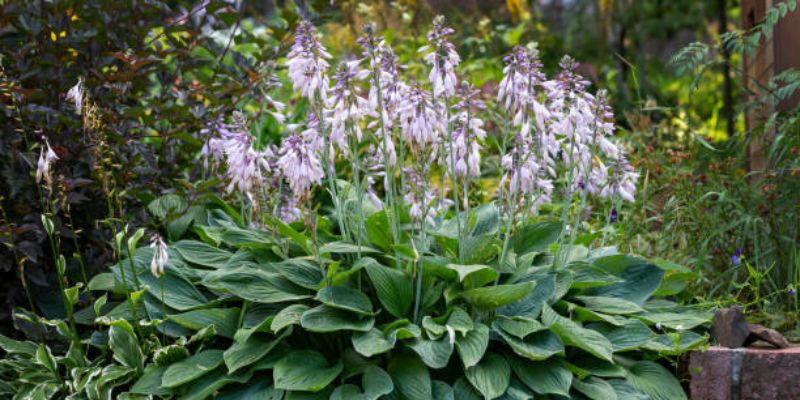
Hostas are a genus of perennials in the family Asparagus, native to East Asia. These plants vary greatly in size and shape, ranging from small clumps with narrow upright leaves to large patches with broad arching foliage.
The foliage is most often variegated or marbled with shades of green, blue-green, yellow, and white. Hostas also produce spikes of lily-like flowers during the summer months.
Soil And Light Requirements
Hostas thrive best in rich, well-draining soil located in a shady spot out of direct sunlight where they will receive partial sun throughout the day or dappled shade under trees or shrubs.
It is important to provide excellent drainage and adequate soil preparation, such as adding compost, prior to planting.
Watering And Fertilization
Hostas should be watered regularly during the growing season but allowed to dry out slightly between watering times.
A balanced slow-release fertilizer can be used in early spring for the best results. Avoid overwatering or overfertilizing as this will cause foliage burn or root rot and weaken the plant.
Maintenance Tips
Deadheading is not necessary with hostas, although if flower stalks become too tall they may need to be cut back to maintain a neat appearance.
Mulching around the plants helps to keep weeds at bay while also providing some insulation when temperatures drop below freezing in winter months.
Common Pests And Diseases
Slugs are the most common pest affecting hostas, so it is important to keep a watchful eye out for them and remove them promptly if spotted.
However, they can usually be kept at bay by maintaining healthy soil and proper irrigation practices. Fungal diseases such as leaf spots or rust may occur in overly wet or humid conditions, but this is not typically an issue with hostas planted in well-draining soils.
Uses In Landscaping
Hostas make great additions to any garden or landscape due to their beautiful foliage and easy care requirements.
They are perfect for shady areas where other plants may struggle to thrive, adding color and texture even when there is low light.
Hostas also make attractive borders, mass plantings, and container gardens. Their flowers can also be used in cut flower arrangements.
Overall, hostas are some of the easiest perennials to grow and require minimal care once established. With a little bit of planning and preparation, they can provide years of beauty with very little effort on the part of the gardener.
Whether you choose to use hostas as an accent plant or a focal point in your garden, their unique foliage and colorful blooms will surely add interest to any landscape setting.
Russian Sage (Perovskia)
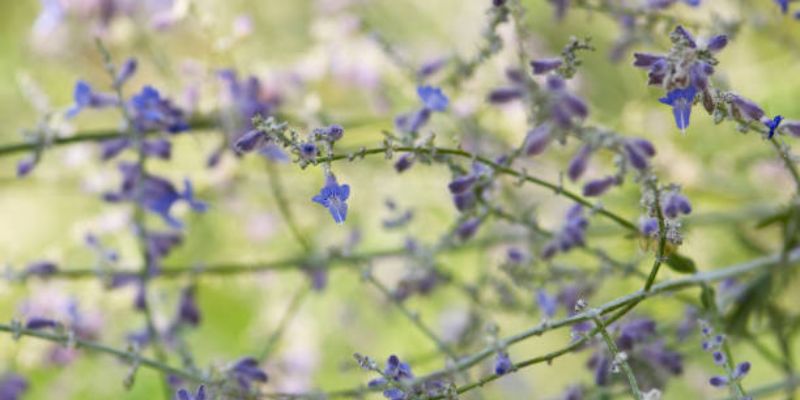
Russian Sage, also known as Perovskia, is a perennial herbaceous plant native to Central Asia. It typically grows about two to three feet tall and has finely textured foliage with an upright, bushy habit.
The leaves are gray-green in color and the stems have a fine powdery coating. In midsummer and late summer, long spikes of tiny blue-purple flowers will appear on the tips of stems.
Soil And Light Requirements
Russian Sage prefers well-drained soil that is kept evenly moist and fertile. Full sun exposure is required for optimal growth; however partial shade can be tolerated if necessary.
Watering And Fertilization
Water deeply but infrequently, allowing at least an inch of water per week. Fertilize with a general-purpose fertilizer in the spring before flowering.
Maintenance Tips
For best results, prune Russian Sage back to just above the ground level in late winter or early spring before new growth begins.
Pruning will help keep the plant neat and compact, while also increasing air circulation which can prevent fungal diseases. Deadheading spent flowers will also encourage repeat blooming throughout the season.
Common Pests And Diseases
Russian Sage is generally pest-free; however, it can be susceptible to aphids and spider mites if conditions are too dry or humid for extended periods of time. Additionally, powdery mildew can occur if humidity levels are high or there is inadequate air circulation.
Uses In Landscaping
Russian Sage is an excellent choice for a low-maintenance garden, as it does not require much pruning and can be drought-tolerant once established.
It can be used along walkways and pathways or planted in masses as a colorful ground cover. Its blooms also make it ideal for adding color to perennial beds, containers, and window boxes.
Because of its ability to attract pollinators such as bees and butterflies, Russian Sage is also a great addition to any wildlife garden.
Russian Sage is easy to grow and maintain, making it one of the easiest perennials to have in the garden. With its attractive foliage and long-lasting blooms, this hardy plant will bring beauty and life to any landscape.
Conclusion
Perennial plants are a great way to add color and interest to any landscape. The eight easiest perennials to grow discussed in this article offer unique foliage and colorful blooms, require minimal care once established, and attract pollinators.
Whether you’re looking for an accent plant or something more substantial like a ground cover, these easy-to-grow perennials will provide years of beauty with very little effort on your part.
With their hardy nature and low maintenance requirements, they’re sure to make gardening a breeze.
Overall, it doesn’t take much effort or knowledge in order to successfully incorporate these beautiful plants into your garden space.
With the right soil conditions, light requirements, and regular maintenance practices there is no reason why you can’t enjoy years of beauty with these eight easy perennials.
